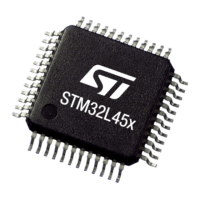Table 47. GPIO_SM_3
SM CODE GPIO_SM_3
Description GPIO port configuration lock register
Ownership ST
Detailed implementation
This safety mechanism prevents configuration changes for GPIO registers; it addresses
therefore systematic faults in software application.
The use of this method is encouraged to enhance the end-application robustness for
systematic faults.
Error reporting Depends on implementation
Fault detection time Depends on implementation
Addressed fault model None (Systematic only)
Dependency on Device configuration None
Initialization
Application software must apply a correct write sequence to LCKK bit (bit 16 of the
GPIOx_LCKR register) after writing the final GPIO configuration.
Periodicity Continuous
Test for the diagnostic Not applicable
Multiple-fault protection Not required
Recommendations and known limitations
This method does not address transient faults (soft errors) that can possibly cause bit-flips on
GPIO registers at running time.
3.6.9 Debug system or peripheral control
Table 48. DBG_SM_0
SM CODE DBG_SM_0
Description Watchdog protection
Ownership ST
Detailed implementation
The debug unintentional activation due to hardware random fault results in the massive
disturbance of CPU operations, leading to an intervention of the independent watchdog or,
alternatively, the other system watchdog WWDG or the external one (CPU_SM_5).
Error reporting Reset signal generation
Fault detection time Depends on implementation (watchdog timeout interval).
Addressed fault model Permanent/transient
Dependency on Device configuration None
Initialization Depends on implementation
Periodicity Continuous
Test for the diagnostic Refer to CPU_SM_6.
Multiple-fault protection CPU_SM_1: Control flow monitoring in Application software
Recommendations and known limitations None
Table 49. LOCK_SM_0
SM CODE LOCK_SM_0
Description Lock mechanism for configuration options
Ownership ST
UM2305
Hardware and software diagnostics
UM2305 - Rev 10
page 33/110

